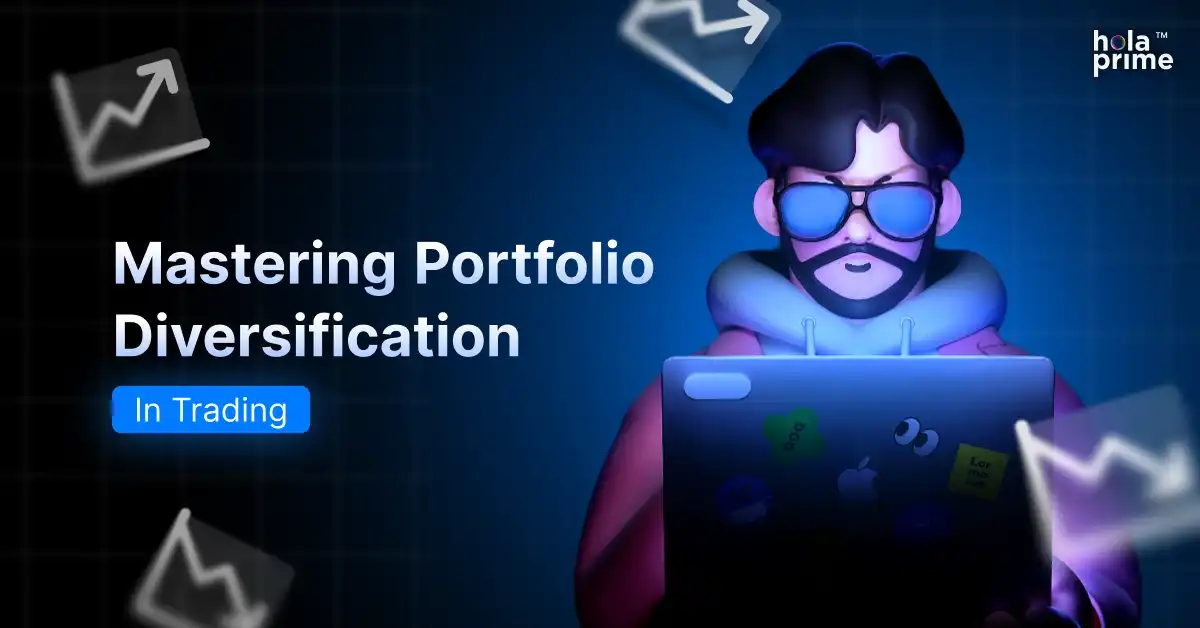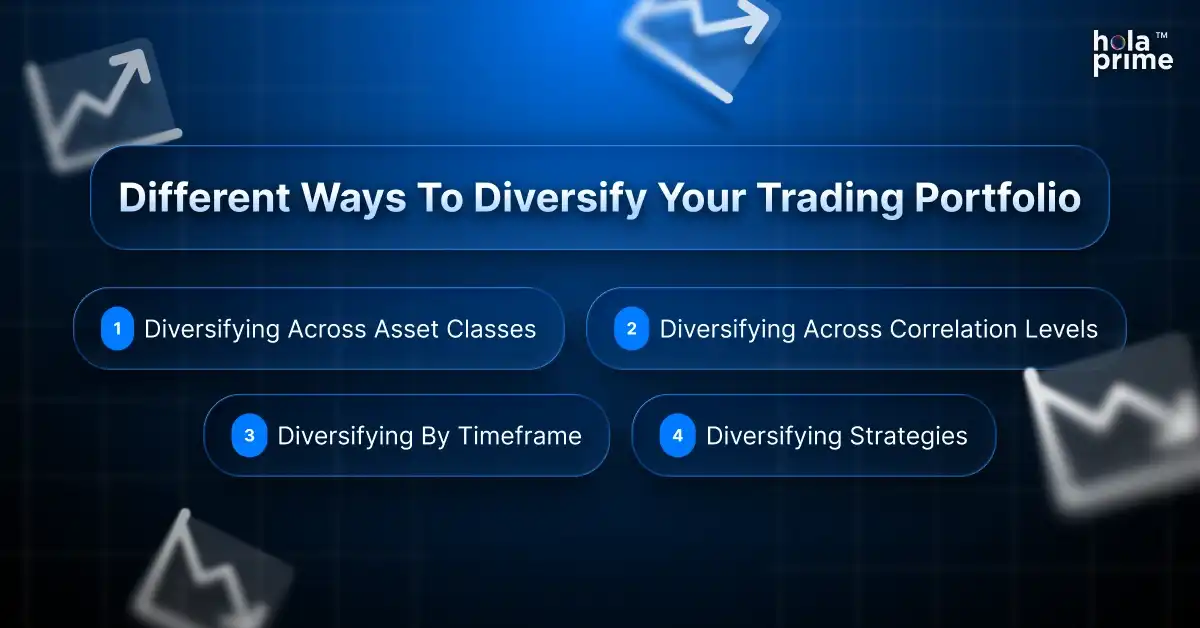Mastering Portfolio Diversification in Trading
- Ankit Gupta
- August 14, 2025

Introduction:
If there’s one piece of advice I could give to traders who want to stay in the game for decades, it’s this: Don’t put all your eggs in one basket. I’ve seen traders blow up accounts, not because they didn’t know how to trade, but because they bet everything on one market, one idea, or one outcome. Diversification is your safety net. It’s what allows you to keep trading tomorrow even if today didn’t go your way. In trading, preservation of capital isn’t a fancy concept – it’s survival.
When you diversify your portfolio the right way, you’re not just spreading risk blindly. You’re creating a balanced system where one losing position doesn’t have the power to wipe out your entire trading plan. Think of it as a ship with multiple compartments – if one takes on water, you don’t sink.
What is Portfolio Diversification in Trading?
Portfolio diversification in trading is the process of spreading your capital across different instruments, timeframes, and even strategies so that no single trade or market condition can completely dictate your results. This isn’t just something long-term investors do; traders need it too. Whether you’re a scalper in Forex, a swing trader in commodities, or a futures day trader, diversification can be the difference between consistent returns and emotional chaos.
The point isn’t to trade everything. The point is to trade different enough things so that your portfolio’s health isn’t tied to a single event or news headline. For example, if you’re trading only forex, unexpected news could hit all your positions at once. But if you have a mix of currencies, commodities, and maybe an index or two, the blow is softened.
Why Diversification Matters for Traders?
Many traders think diversification slows them down. They feel that focusing on one market gives them an edge. That’s true, but the market doesn’t always reward focus – sometimes it punishes it. Imagine you’re a gold-only trader and gold goes into a three-month range with no clear trend. You’re stuck waiting while your capital does nothing. On the other hand, if you’re also active in crude oil futures or the S&P 500, you can keep generating opportunities while gold takes its nap.
Diversification helps in three main ways:
- Reduces overall risk exposure.
- Balances performance during volatile times.
- Prevents over-reliance on a single market condition.
It’s not about avoiding risk completely – that’s impossible in trading – but about managing it so that your account survives through different market cycles.
Different Ways to Diversify Your Trading Portfolio:
Diversification isn’t just about trading multiple markets. There are several angles to it:

1. Diversifying Across Asset Classes:
Don’t limit yourself to just one asset type. A trader who has exposure to Forex, commodities, indices, and maybe even cryptocurrencies can often balance the ups and downs better than someone who’s all-in on a single category. For instance, when currencies are crashing, gold might be rallying. When oil prices drop, certain currencies may strengthen.
2. Diversifying Across Correlation Levels:
Some markets move together (correlated), while others move independently (uncorrelated). The trick is to mix them.
Asset Type | Correlation with S&P 500 | Notes |
Gold | Low to Negative | Often rises when stocks fall |
Crude Oil | Medium | Tied to global growth outlook |
EUR/USD | Medium to High | Can move with risk sentiment |
USD/JPY | Low to Negative | Often acts as a safe haven |
If you’re trading two highly correlated markets (like the Nasdaq and S&P 500), you’re basically doubling your risk on the same idea. Mixing correlated and uncorrelated instruments keeps things balanced.
3. Diversifying by Timeframe:
One of the most overlooked forms of diversification is trading different timeframes. For example, you could be scalping EUR/USD on a 5-minute chart while also holding a swing position on gold that you plan to keep for several days. If one strategy isn’t producing results right now, the other can still keep you profitable.
4. Diversifying Strategies:
Using multiple strategies ensures that you’re not relying on just one way of making money. A breakout strategy, for example, will thrive in trending markets but struggle in ranges. Meanwhile, a mean reversion strategy does the opposite. Combining both allows you to adapt automatically as market conditions change.
How Prop Traders Use Diversification?
In prop trading firms, diversification isn’t just a nice-to-have – it’s a must, if you want to be successful. Firms provide different financial instruments; hence, traders can trade forex, commodities, cryptos, and other instruments to better diversify their portfolio. In your prop trading account, spreading trades across instruments and strategies can help you meet profit targets while keeping risks minimized.
Risks and Misconceptions About Diversification:
While diversification can protect you, it’s not a magic shield. Here are some things you need to keep in mind:
- Over-diversification can dilute your edge. If you’re trading too many markets you don’t fully understand, you’re setting yourself up for sloppy mistakes.
- False diversification is the case when you think that you are diversifying your portfolio but you are trading the same asset classes.
- Execution discipline is crucial. Managing multiple markets requires more attention, so you can’t afford to be lazy with stop-losses and risk allocation.
Risks and Misconceptions About Diversification:
- Start small. If you’re new, begin with two or three different markets before expanding.
- Understand each market’s personality. Gold trades differently from crude oil, which trades differently from EUR/USD.
- Always check the correlation before entering multiple trades.
- Keep a watchlist. It helps you scan opportunities quickly without being overwhelmed.
- Review your diversification regularly. Market correlations change over time – adapt with them.
Conclusion:
Diversification is not a way of hiding away from risk, but rather a smart way of dealing with it effectively. The markets are unpredictable. Your job is to make sure your portfolio isn’t. Spread your risk, manage it well, and you’ll trade with the kind of confidence that only comes from knowing one day won’t end your career.
FAQs: Portfolio Diversification
1. What’s the best way to start diversifying as a beginner?
The best way to diversify is to simply pick few different instruments of differnet classes, varied correlation, and different time frames. One common mistake beginners do is trying to over diversify, which often make things complicated and kill profit making opportunities.
2. Should I diversify across timeframes too?
Yes, that’s an excellent idea. You can make some trades with a short time frame and some trades with a longer time frame, so that you don’t end up blowing your account from market volatility.
3. Does diversification reduce profits?
Not really, diversification just means that you are not putting all your capital in one or two instruments. Your profit depends on how your trades perform.
4. What is the diversification of a portfolio?
Portfolio diversification is a practice of adding different instruments to a trading portfolio in order to diversify and minimize risk. It helps the overall positive stay in green, even if one or two instruments don’t perform well.
5. What is correlation in diversification?
Correlation is the relation between two instruments or classes. A positive correlation suggests that both instruments will go upwards and downwards simultaneously, and a negative correlation means that when one instrument goes up, the other will go down.
Disclaimer: All information provided on this site is for educational purposes only, related to trading in financial markets. It is not intended as financial advice, business or investment recommendation, or as an opportunity or recommendation to trade any investment instruments. Hola Prime only provides an educational environment to traders, including tools, materials and simulated trading platforms which have data feed provided by Liquidity Providers. The information on this site is not directed at residents in any country or jurisdiction where such distribution or use would be contrary to local laws or regulations.

